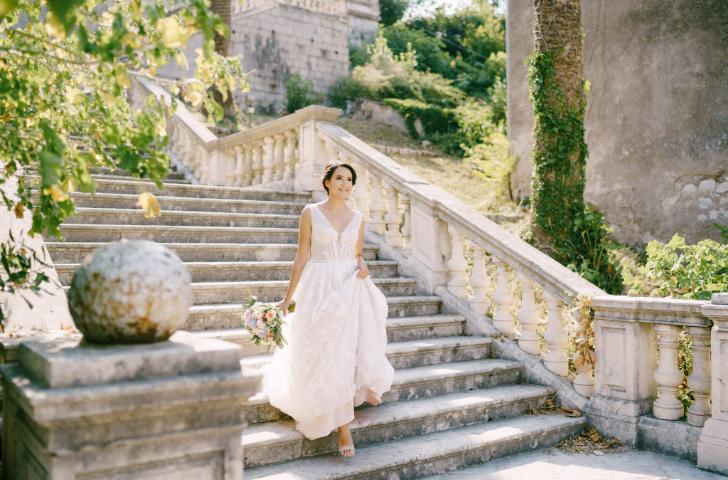The quest for the perfect wedding dress is a journey many brides find both exhilarating and daunting. Amid wedding planning, the dress stands out as a symbol of personal style, a vital element of the celebration. It is a unique and magical moment for the bride, and there are plenty of ideas. But who says you have to stick to the conventional? Drawing inspiration from the past and future trends, we’re sure this guide will help you discover which dress style best fits you!
A Nod to Tradition: Queen Victoria and The Legacy of the White Dress
In the past, wedding dresses were not necessarily white. According to the Royal Collection Trust, the iconic white wedding dress started with Queen Victoria, who, in 1840, chose to wear white to support Britain’s lace industry. But it became much more than a tradition: it became a global trend. “As a big fashion icon, people all over Europe started to follow Queen Victoria’s white dress idea, making it a tradition,” notes historical accounts. The white dress symbolized purity and innocence, and its color appeal was further enhanced by its striking appearance in black-and-white photography.
Decades of Elegance: The Evolution of Wedding Dresses
1840-1949: From the 1840s until the 1949s, silk was the bride’s favorite. The high necks and elaborate hair accessories were also becoming more popular these years, setting a tone of elegance. The Bridal Gallery of Orlando store says that brides wanted to show power at that time, so extravagance and elegance were a priority.
1950-1999: Post-1950s, the trend shifted to more feminine romantic silhouettes, with shorter dresses and veils coming into vogue. Wedding dress stores around Orlando say that these characteristics have become timeless.
2000-2023: The new millennium saw a mix of off-the-shoulder designs, luxurious laces, full skirts and minimalist styles. Central Florida bridal stores observe a current preference for clean, simple lines.
Most wedding dress stores around Central Florida say brides nowadays “prefer more wedding dresses with clean looks, straight lines, simple and minimalist,” reflecting a blend of modern sensibilities with timeless elegance. But some people will always look for past decades’ more popular traditional dress styles. “You will always find some traditional, romantic dresses, but you can see more modern trends as well, like the mermaid style,” says Sira D’ Pion, owner of the Sira D’ Pion Atelier in Winter Park.
Bridal Fashion Forward: What’s Trending in 2024
As we look to the future, the bridal fashion landscape includes a bit of everything. New York Bridal Fashion Week and insights from local industry insiders paint an exciting picture for 2024:
- Colorful Expressions: Brides embrace color by moving away from the traditional white. “Wedding dress stores say that colored dresses are becoming more common, but the choices depend highly on the mood of the wedding and what the couple wants to pass to their guests,” indicating a shift toward more personalized and mood-reflective choices.
- Floral Renaissance: “This spring, flowers will capture the attention of wedding dress trends,” says D’ Pion. The popularity of floral prints signifies a celebration of love and beauty, integral to the essence of weddings. This renaissance will include small flowers over the skirt, flower-print dresses with different designs and big floral appliques.
- The Charm of Bows: Bows are making a comeback, adding a touch of whimsy and elegance to bridal attire. Instead of decorating only the dress, the bow format style on the upper part of the dress will be a trend. The Collection Bridal Store in Winter Park says, “It is no surprise that bows will be trending,” highlighting their enduring appeal.”
Gentlemen’s Attire: A Brief Look at Men’s Wedding Fashion
Men’s wedding attire has also undergone significant transformations, from the formal morning suits of the early 20th century to the sleek, tailored looks of today. The diversity in men’s fashion reflects a broader acceptance of individual style and the breaking of traditional norms.
Like Queen Victoria changed the history of wedding attire in the 1840s, Prince Albert of Saxe-Coburg, her husband, changed the suits. He used the cutaway front and the tail on the jacket, which was new then. He would combine a soldier’s uniform and morning suit, setting a new trend for grooms.
1840-1949: During this time, grooms used a simple design. Trousers were baggy and high-waisted. Pocket squares were also standard. As time progressed, men protected their wealth by showing their suits. Colorful shirts, ties, tie pins and cufflinks showcased different fashion styles.
1950-1999: At the beginning of 1950, grooms followed a design called morning suits. Weddings were mainly conducted in the morning, so the trend of suits included the composition of tailcoats, waistcoats and formal trousers made of wool.
2000-2023: Like brides, grooms used more simplistic, clean-cut and crisp suits. The idea is that suits be tailored to fit the groom’s shape. But there has been an uptick in investment in different colored suits, such as dark blue or brown. Nowadays, suit options are endless and fashion rules are less restrictive.
Envisioning 2025: The Future of Wedding Fashion
As we anticipate 2025 trends, the bridal industry will embrace elegance and comfort, with mid-skirt dresses, pants and jumpsuits leading the way. These trends suggest a move toward versatility and personal expression in bridal fashion.
Wedding dresses (and suits) are about feeling one’s best in the special moment, a love story to celebrate. Every bride and groom is different, but nowadays, the world accepts versatility. So whether you appreciate the timeless elegance of a classic gown or suit or the colorful contemporary design, the chosen wedding wear should reflect your personality and taste.



Comments